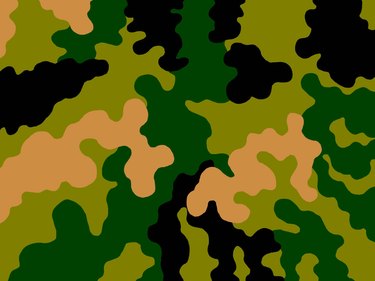
With the very elements in nature you want to blend into, you can paint your own camouflage pattern. Create a homemade stencil that you can use with spray paints, a paint roller or paintbrush, as desired. Choose colors from the outdoors, and add neutral colors to make everything blend well. Paint the background in the predominant color from nature, such as forest green, desert sand or mountain brown or gray, and then add your template or stencil for painting the other areas to create the camo.
Pick the Patterns
Video of the Day
Pick the patterns you want to emulate in your camouflaged piece. For example, if you want something with a forest theme, choose large and small leaves and branches. Use the elements from nature where you need the camouflage. Avoid geometric shapes or shapes that have a man-made appearance. Don't use straight lines, because they usually don't exist in nature. You can draw freehand to create a stencil or use elements from nature, such as large leaves, as your template.
Video of the Day
Choose the Colors
Choose a base color, and then a secondary and a third. Use lighter or darker colors for the highlighted areas to create a camouflage pattern. Stay away from paints with a high sheen; instead, choose paints with a flat, matte or low luster finish, as you don't want the camouflage pattern to appear shiny. Choose a flat primer. Color ideas include a forest green background, dirt browns, sandy beiges or varying shades of green. For a desert camo pattern, stick to browns, beiges and tans.
Make Stencils
If you have several items you want to cover with camouflage, make several different stencils from cardboard using the patterned items you chose. If you only have one item to camo paint, use the leaves or items from nature directly as your stencil. Outline leaves, for example, onto a piece of cardboard, and then cut out the area of the leaves with scissors or a craft knife. Include a small branch and more than one leaf on the template. Make two to three different stencils using leaves from different trees to replicate nature.
Primer and Base Coat
Cover the item to be camouflaged with a flat gray or beige primer; let it dry, and then sand with 220-grit sandpaper. Cover it with the base coat -- light or dark green, beige or brown paint. Spray paints work the best, but you can also use a paint roller or a paintbrush if you're using a stencil. Cover the entire surface, but don't worry if it looks blotchy. Let it dry thoroughly.
Painting With Stencils or Templates
If you're only painting one item, place the leaves, for example on the item, over the base coat, and then spray around them with spray paint. When you remove the leaves, you'll have leaf-shaped areas in the base coat color with the lighter or darker color around it. Repeat this as many times as necessary all around the piece, after each coat has dried for at least 20 to 25 minutes. Use two to three colors, as desired, to create the camouflage pattern. Cover it with at least 45 percent of the background color showing through, 40 percent of a secondary and 15 percent of a third color. The ratio is a personal choice, but the more variety, the better.
Items to Camouflage
You can use this method to camouflage old vehicles; kids' forts; hunting blinds; boards; fabrics such as canvas; ice chests; containers and coolers. If you find a particular pattern you like, make it into a stencil from cardboard or use a stencil acrylic material available from arts, crafts and hobby stores. You can also buy the stencils premade from sporting goods stores, if desired.